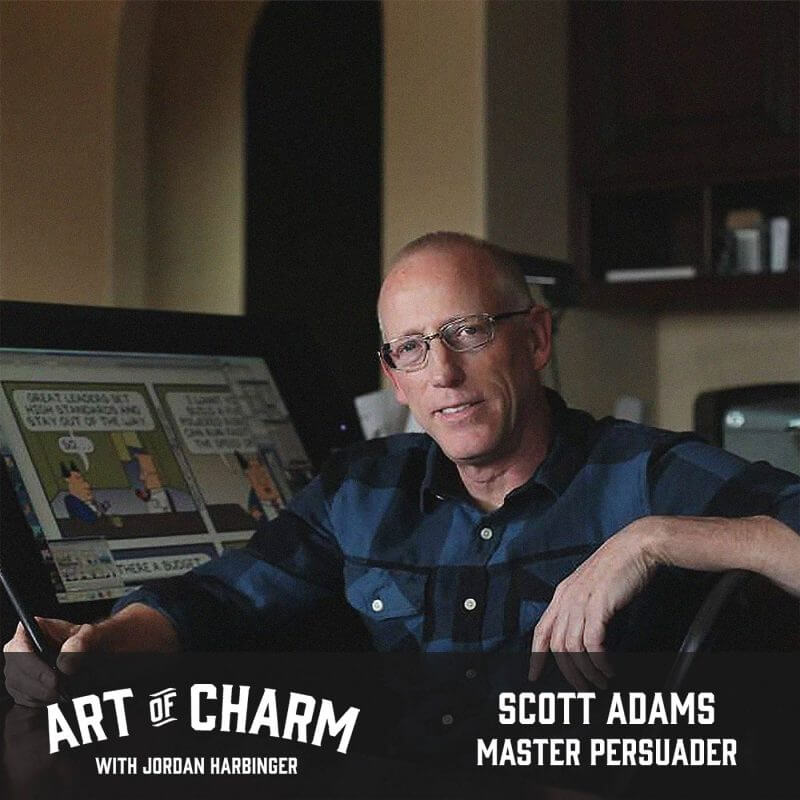Scott Adams (@ScottAdamsSays) is a trained hypnotist, the creator of Dilbert, and author of the upcoming book Win Bigly: Persuasion in a World Where Facts Don’t Matter. He also predicted a 2016 presidential win for Trump — for reasons others didn’t see.
“Check your facts.” -Scott Adams
The Cheat Sheet:
- Did Donald Trump win the election because his persuasion skills include elements of hypnosis?
- Why is visual persuasion so effective?
- How do we spot the moment when people are trying to influence us?
- How is pacing and leading used for persuasion?
- We revisit the copy machine effect and learn a new one: the McGurk effect.
- And so much more…
[aoc-subscribe]
No matter where you stand on the outcome of the 2016 presidential election, there’s no denying it took a lot of the country by surprise. Pundits who predicted another result as inevitable scrambled to save face, and one question was almost unanimous among those crestfallen by the final tallies: “How?”
Scott Adams, creator of the popular Dilbert comic and author of the upcoming Win Bigly: Persuasion in a World Where Facts Don’t Matter, is among the rare few who were not surprised by the outcome. How did his background as a trained hypnotist give him insight leading to an accurate prediction that others missed? Listen, learn, and enjoy!
More About This Show
How is it that Scott Adams, creator of Dilbert and author of the upcoming Win Bigly: Persuasion in a World Where Facts Don’t Matter, predicted a presidential win for Donald Trump in the 2016 election when nearly everyone else seemingly in the know was convinced it would go to Hillary Clinton?
“I’m a trained hypnotist,” says Scott. “I learned hypnosis when I was in my twenties. And when I saw Trump enter the stage, I saw a level of persuasive talent that didn’t look accidental. He’s someone who has acquired these skills over a lifetime; he wrote a book on it. The Art of the Deal is essentially persuasion in the form of negotiating. And he talks about persuasion. He talks about it all the time. And when I saw it, I thought, ‘I think I’m seeing something other people aren’t seeing because I have a certain training.’
“I’ve been learning persuasion for decades after I learned hypnosis specifically and I just saw more technique and I thought, ‘He’s bringing a flamethrower to a stick fight and this isn’t going to be fair.'”
The 2D World and 3D World of Persuasion
Scott makes a distinction between what he calls the 2D world and the 3D world of persuasion.
“In the 2D world, facts matter and policies matter and all that stuff,” he says. “But I think we’ve seen that’s not the case. When I was saying it a year ago, it was actually radical, and I’m pretty sure no one else was saying it. But if you look at any of the headlines of the past month, you’re going to see a lot of people saying, ‘Why is it that people are so irrational? Why do people make decisions this way? How did we get Brexit? How did we get Trump?’ So the world has moved over to my point of view.”
Visual Persuasion
Scott made numerous predictions while watching debates leading up to the election. One was that Trump’s pantomimed mockery of a story told by Ben Carson — who was then leading for the Republican nomination — would result in Carson’s loss.
“I watched that performance and it was so visual that I thought, ‘This is going to be way more powerful than people think,’ and I predicted that was the end of him,” says Scott.
Don’t Overspecify
“One of the tricks of persuasion is you want to directionally tell someone to imagine a certain thing, but you don’t want to overspecify. Because as soon as you overspecify, people say, ‘Oh, that wasn’t what I was seeing,’ or, ‘I don’t have a memory of that, exactly.’ But if you say, ‘Imagine you’re in nature,’ or, ‘You’re in the forest,’ people just see their own forest. And then that makes them happy.”
Listen to this episode of The Art of Charm in its entirety to learn more about how a careless act of visual persuasion accidentally lost Carly Fiorina her chance at the Republican nomination, how you might use visual persuasion on a date, why you should avoid overspecification when you’re trying to directionally persuade someone with imagery, why charging for a service you offer gives you the leverage to be a better persuader, why conjuring the image of Rosie O’Donnell during a debate worked in Donald Trump’s favor, how pacing and leading is used for persuasion, what the McGurk effect is, and much more.
THANKS, SCOTT ADAMS!
If you enjoyed this session with Scott Adams, let him know by clicking on the link below and sending him a quick shout out at Twitter:
Click here to thank Scott Adams at Twitter!
Resources from This Episode:
- Transcript for Scott Adams | Master Persuader (Episode 605)
- Win Bigly: Persuasion in a World Where Facts Don’t Matter by Scott Adams
- How to Fail at Almost Everything and Still Win Big: Kind of the Story of My Life by Scott Adams
- Dilbert
- WhenHub
- Scott Adams’ blog
- Scott Adams at Periscope
- Scott Adams at YouTube
- Scott Adams at Twitter
- Why I Switched My Endorsement from Clinton to Trump by Scott Adams [where the term “pacing and leading” is explained]
- Robert Cialdini | Pre-suasion (Episode 543) [the Copy Machine effect]
- Ryan Holiday | Ego Is the Enemy (Episode 519)
- The McGurk effect
You’ll Also Like:
- The Art of Charm Challenge (click here or text 38470 in the US)
- The Art of Charm Bootcamps
- Best of The Art of Charm Podcast
- The Art of Charm Toolbox
- The Art of Charm Toolbox for Women
- Find out more about the team who makes The Art of Charm podcast here!
On your phone? Click here to write us a well-deserved iTunes review and help us outrank the riffraff!




